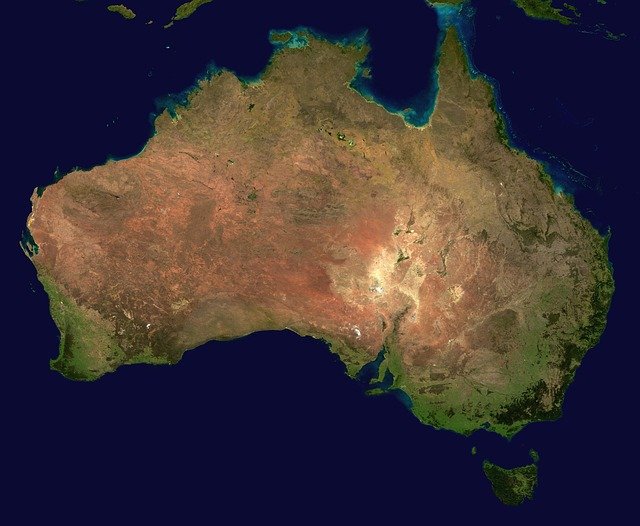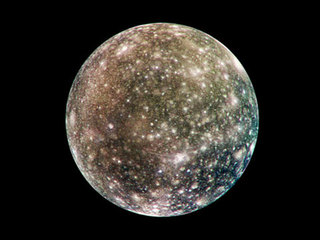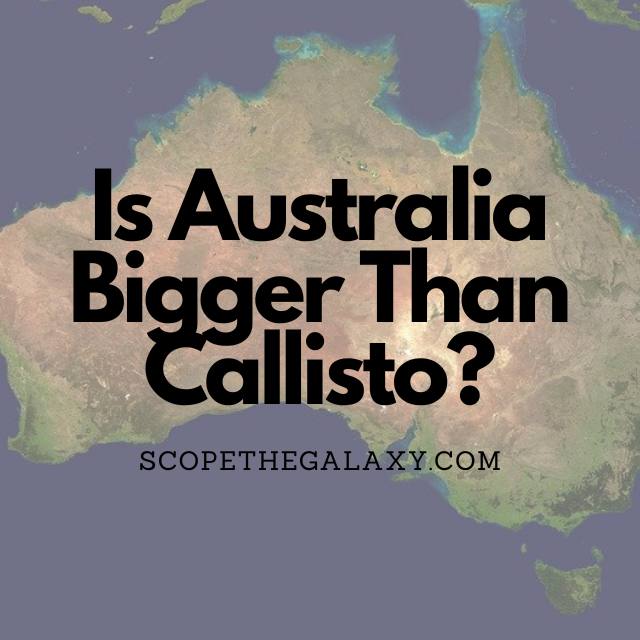*This post may contain affiliate links. This means we may make a commission if you purchase an item using one of our links*
Australia has a surface area of 7.61 million sq. kilometers and a volume of 304 million cubic kilometers while Callisto is a spherical entity with a surface area of 73 million sq. kilometers and a volume of 59 billion cubic kilometers. As a result it only makes sense that Callisto would be the bigger of the two as it is a spherical object whereas Australia is a mostly flat land mass.
For a more detailed breakdown on the sizes of both bodies continue reading as it will be covered in more depth the sections below.
How Big Is Australia?

Australia is the sixth largest country in the world, following Russia, Canada, China, the USA, and Brazil. This commonwealth country comprises mainland Australia plus Tasmania and several other smaller islands; this land has a total area of 7,617,930 sq. km.
As for the overall volume of Australia, if we consider that Earth’s crust ranges from around 5 to 70 km in thickness. Generally, this crust is thicker under the continental land, which averages 40 km.
Therefore, by taking this average of 40km and multiplying it by the surface area of Australia, the volume would come up to roughly 304,717,200 cubic km.
The diameter of Australia, measuring from East to West, is 4000km, making it wider than the moon along with a large number of the smaller moons and planets like Pluto.
Within this expansive continent is a collection of mountainous regions and ranges. The largest is the Great Dividing Range or the Eastern Highlands, which stretch 3,500km parallel to the East Coast.
Within the Great Dividing range lie the Australian Alps, a mountain range that is host to some of the highest peaks in the country, including Mount Kosciuszko, which is 2,228m high.
Fifty kilometers to the west of Sydney are the Blue Mountains, which are named for the blue haze filling the surrounding area. While these mountains are impressive, Australia has surprisingly few notable peaks considering its size. Instead, it has vast expanses of desert known as the Australian outback.
How Big Is Callisto?

Callisto is a moon of Jupiter and the third largest moon in the Solar System, which was discovered in January 1610 by Galileo Galilei.
The diameter of Callisto is 4,820.6km, while its surface area is 73,000,000 sq. km, a far greater expanse than that of Australia. Still, like our seventh largest country, the terrain of Callisto varies, and it is the most heavily cratered object in our solar system.
Calisto’s volume is an impressive 59,000,000,000 cubic km, giving it a similar size to the planet Mercury (60.8 billion cubic km). Callisto is classified as a moon and not a planet because it orbits Jupiter rather than the Sun. Still, it is one of the largest moons in the Milky Way and covers an impressive expanse.
This mega moon is 99% as big as Mercury, but it only possesses a third of its weight because of the moon’s mixed composition.
Callisto’s average density is 1.83 cubic cm, which suggests that it is made of roughly equal parts of water ice and rocky material, plus additional volatile ices (like ammonia). Scientific research into the moon suggests that 49-55% of its total constitution is ice. The remaining rock is likely composed of silicates, chondrites, and iron oxide.
Still, the water ice only accounts for between 25 and 50% of the planet’s overall mass.
The surface of Callisto is heavily cratered and has a dark appearance. Scientists believe that the bright patches consist mainly of ice, while the darker patches show areas where the ice has eroded. The most distinctive crater is Valhalla, with its bright central region.
In the past, many scientists thought this huge “hunk of rock and ice” was “boring” because it had no shifting tectonic plates and no volcanic activity. At first appearances, it seemed to be a dead world.
Still, more recent research by NASA scientists concludes that Callisto could house a salty ocean interacting with rocks that are more than 250 km below the surface. Combine this with detections of oxygen in the exosphere, and today Callisto is included in the list of places where life could exist beyond Earth.
Callisto is 180 times farther from Earth than our moon, but its large amount of surface ice makes it shine brighter than our moon. Earth’s moon reflects only 0.12% of the Sun’s light, whereas Callisto reflects up to 20%.
Summary
Although Australia is amongst the largest countries on Earth, it really doesn’t hold a candle to Callisto in its overall physical stature, both in surface area and most certainly in regards to volume.
Callisto has a surface area just under 10 times that of Australia and a volume around 190 times bigger too. After all the moon’s spherical shape will always edge out flatter land masses, if all things are relatively equal in diameter and when they aren’t.

